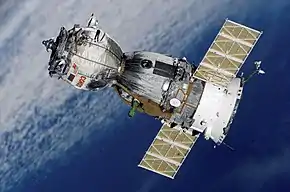Kosmos 140
Kosmos 140 (Russian: Космос 140 meaning Cosmos 140), Soyuz 7K-OK No.3, was an uncrewed flight of the Soyuz spacecraft.[3] It was the third attempted test flight of the Soyuz 7K-OK model, after orbital (Kosmos 133) and launch (Soyuz 11A511) failures of the first two Soyuz spacecraft.
| Mission type | Test flight |
|---|---|
| Operator | Experimental Design Bureau (OKB-1) |
| COSPAR ID | 1967-009A |
| SATCAT no. | 02667 |
| Mission duration | 2 days |
| Spacecraft properties | |
| Spacecraft | Soyuz 7K-OK No.3 |
| Spacecraft type | Soyuz 7K-OK |
| Manufacturer | Experimental Design Bureau (OKB-1) |
| Launch mass | 6450 kg [1] |
| Landing mass | 2500 kg |
| Dimensions | 7.13 m (23.4 ft) long 2.72 m (8 ft 11 in) wide |
| Start of mission | |
| Launch date | 7 February 1967, 03:21 GMT [2] |
| Rocket | Soyuz 11A511 s/n U15000-03 |
| Launch site | Baikonur, Site 1/5 [1] |
| Contractor | Experimental Design Bureau (OKB-1) |
| End of mission | |
| Landing date | 9 February 1967 |
| Landing site | Aral Sea, Kazakhstan |
| Orbital parameters | |
| Reference system | Geocentric orbit [2] |
| Regime | Low Earth orbit |
| Perigee altitude | 165.0 km |
| Apogee altitude | 218.0 km |
| Inclination | 51.7° |
| Period | 88.5 minutes |
History
The follow-up to Kosmos 133 (Soyuz 7K-OK No.2), 28 November 1966, was planned for 14 December 1966 (Soyuz 7K-OK No.1) but ended disastrously. At liftoff, the Blok A core stage of the 11A57 booster ignited, but not the strap-ons. A shutdown command was immediately sent and pad crews began to move the service towers back in place and drain the propellants. This task was completed for the core stage and strap-ons, and then about 27 minutes after the attempted launch, the launch escape system (LES) suddenly fired. Its exhaust caused the Blok I third stage propellant tanks to overheat and explode, killing one person on the ground and damaging the Soyuz and core stage/strap-ons beyond repair. LC-31 was also badly damaged and took seven months of repair work in the frigid Kazakhstan winter to be restored to use. The reason for the LES firing was thought to be either a timer being activated due to the Earth's rotation affecting the gyroscope package in the launch vehicle or perhaps one of the service towers bumping it.
Launch
In February 1967, the backup booster and spacecraft were set up at LC-1 and the planned mission could be carried out. Kosmos 140 was operated in a low Earth orbit, on 7 February 1967, it had a perigee of 165 km (103 mi), an apogee of 218 km (135 mi), an inclination of 51.7°, and an orbital period of 88.5 minutes.[2]
Return
The spacecraft suffered attitude control problems and excessive fuel consumption in orbit, but remained controllable. An attempted maneuver on the 22nd orbit still showed problems with the control system. It malfunctioned yet again during retrofire, leading to a steeper than planned ballistic reentry and a 30 centimetres (12 in) hole being burned in the heat shield.[1]
Although the event would have been lethal to any human occupants, the capsule's recovery systems operated and the capsule crashed through the ice of the frozen Aral Sea, hundreds of kilometers short of its landing zone. The spacecraft finally sank in 10 metres of water and had to be retrieved by divers. The test performance was nonetheless deemed "good enough"; the crewed docking missions of Soyuz 1 and Soyuz 2 was approved for the next flight.
References
- "Cosmos 140: Display 1966-109A". nssdc.gsfc.nasa.gov. NASA. 27 February 2020. Retrieved 2 April 2020.
 This article incorporates text from this source, which is in the public domain.
This article incorporates text from this source, which is in the public domain. - "Cosmos 140: Trajectory 1967-009A". nssdc.gsfc.nasa.gov. NASA. 27 February 2020. Retrieved 2 April 2020.
 This article incorporates text from this source, which is in the public domain.
This article incorporates text from this source, which is in the public domain. - "Soyuz spacecraft flights". S.P.Korolev RSC Energia. Retrieved 16 April 2009.
